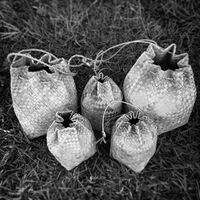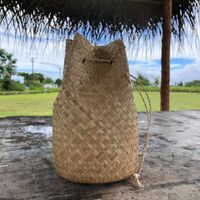Kostat tengguang: Difference between revisions
No edit summary |
No edit summary |
||
| (8 intermediate revisions by the same user not shown) | |||
| Line 1: | Line 1: | ||
Kostat tengguang is a drawstring bag of varying size, generally taller than wide, plaited from [[Åkgak|åkgak]] leaves in a diagonal weave pattern. The drawstring at the top of the plaited bag is generally either twisted åkgak cordage, or round-weave åkgak cordage. | |||
== Uses == | == Uses == | ||
'' | Kostat tengguang is a compound word coming from kostat (Spanish: ''costal'' <ref>[https://www.spanishdict.com/translate/costal Costal – Spanish to English Translation]. SpanishDict.</ref> - n. sack, bag) meaning bag, and ''tengguang''<ref>[http://www.chamoru.info/dictionary/display.php?action=view&id=7969&from=action=view%7Cid=7955 Tengguang – Chamoru-English Dictionary]. Chamoru.info. Entry #7969.</ref> meaning food taken with you. | ||
== History == | == History == | ||
'' | Although the woven kostat tengguang is not used in modern times as a common way of transporting one's food, it is sometimes seen being used as a personal effects bag, betelnut basket, or a purse. Kostat tengguang come in many shapes and sizes, but generally square at the base, and tall. The weaving can start large and be split into halves or quarters and woven up, or it can start very small at around 1/8 in. The kostat tengguang is generally taller than it is wide. It's characteristic feature is that it has a drawstring of some material, either woven, braided, or twisted which is laced through the weaving just below the top which is used to close and secure the container. | ||
== Cultural significance == | == Cultural significance == | ||
''(to be added)'' | ''(to be added)'' | ||
== Gallery == | |||
<gallery widths="200" heights="200"> | |||
File:kostat_tengguang_01.jpg|A group of kostat tengguang (lunch bags) woven from åkgak. The larger kostat tengguang on the left and the smaller one just in front of it were woven by Master Weaver Defunta Tan Elena Benavente from the island of Guam, and the remaining three to the right are reproductions of them woven by Chamoru weaver James C. Bamba. | |||
File:kostat_tengguang_02.jpg|A round bottomed kostat tengguang photographed in Luta, CNMI. Woven by [[James C. Bamba]] | |||
</gallery> | |||
== Museum holdings == | == Museum holdings == | ||
=== The National Museum of Ethnology (国立民族学博物館) === | |||
* [https://htq-fs.minpaku.ac.jp/mocat/K0000711 kostat tengguang (K0000711)] | |||
=== Oakland Museum of California === | |||
* [https://portal.museumca.org/catalog/0e302ade-3ef9-4a00-a427-1ff35a4d64ef kostat tengguang (H79.75.47)] | |||
=== Spain National Museum of Anthropology (Museo Nacional de Antropología – Madrid) === | === Spain National Museum of Anthropology (Museo Nacional de Antropología – Madrid) === | ||
| Line 18: | Line 30: | ||
* [https://ceres.mcu.es/pages/Main?idt=22346&inventary=CE2139&table=FMUS&museum=MNA kostat tengguang (CE2139)] | * [https://ceres.mcu.es/pages/Main?idt=22346&inventary=CE2139&table=FMUS&museum=MNA kostat tengguang (CE2139)] | ||
== References == | == References == | ||
''(to be added)'' | ''(to be added)'' | ||
[[Category:Woven items]] | |||
[[Category:Chamorro material culture]] | |||
[[Category:Tinifok åkgak]] | |||
Latest revision as of 17:33, 13 May 2025
Kostat tengguang is a drawstring bag of varying size, generally taller than wide, plaited from åkgak leaves in a diagonal weave pattern. The drawstring at the top of the plaited bag is generally either twisted åkgak cordage, or round-weave åkgak cordage.
Uses
Kostat tengguang is a compound word coming from kostat (Spanish: costal [1] - n. sack, bag) meaning bag, and tengguang[2] meaning food taken with you.
History
Although the woven kostat tengguang is not used in modern times as a common way of transporting one's food, it is sometimes seen being used as a personal effects bag, betelnut basket, or a purse. Kostat tengguang come in many shapes and sizes, but generally square at the base, and tall. The weaving can start large and be split into halves or quarters and woven up, or it can start very small at around 1/8 in. The kostat tengguang is generally taller than it is wide. It's characteristic feature is that it has a drawstring of some material, either woven, braided, or twisted which is laced through the weaving just below the top which is used to close and secure the container.
Cultural significance
(to be added)
Gallery
-
A group of kostat tengguang (lunch bags) woven from åkgak. The larger kostat tengguang on the left and the smaller one just in front of it were woven by Master Weaver Defunta Tan Elena Benavente from the island of Guam, and the remaining three to the right are reproductions of them woven by Chamoru weaver James C. Bamba.
-
A round bottomed kostat tengguang photographed in Luta, CNMI. Woven by James C. Bamba
Museum holdings
The National Museum of Ethnology (国立民族学博物館)
Oakland Museum of California
Spain National Museum of Anthropology (Museo Nacional de Antropología – Madrid)
References
(to be added)
- ↑ Costal – Spanish to English Translation. SpanishDict.
- ↑ Tengguang – Chamoru-English Dictionary. Chamoru.info. Entry #7969.

